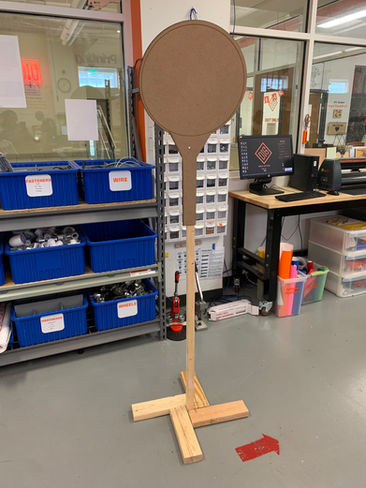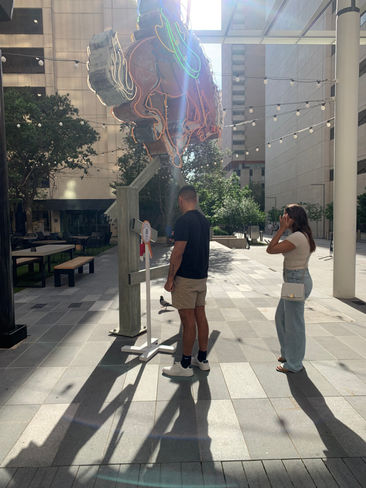top of page
Create Your First Project
Start adding your projects to your portfolio. Click on "Manage Projects" to get started
AT&T: DISCOVERING THE DISTRICT
Location
Dallas, TX
Date
SPRING 2024
Role
Co-Researcher, Co-Strategist, Co-Designer
Project type
Experience Design, AR/VR
Case Study: Enhancing Community Engagement at AT&T Discovery District
Project Overview
As a full-time graduate student at SMU, I participated in a human-centered design project focused on improving community participation at the AT&T Discovery District in downtown Dallas. This district, known for its state-of-the-art facilities, serves as a corporate headquarters and public gathering space. However, despite its modern appeal, community engagement was lower than expected.
Our team sought to identify barriers to participation and develop strategies to enhance visitor engagement and navigation within the district.
⸻
Problem Statement
The AT&T Discovery District was designed to be a dynamic public space, yet it faced challenges in drawing consistent community participation. Many visitors were unsure of the available activities, leading to shorter stays and lower engagement.
Key challenges included:
• Lack of clear signage and wayfinding tools, making it difficult for visitors to navigate the district.
• Limited awareness of activities and offerings, reducing visitor engagement.
• A lack of confidence among visitors unfamiliar with the space, discouraging exploration.
• An opportunity to leverage technology and interactive elements to enhance the visitor experience.
The project aimed to develop a strategy that improves community participation through better wayfinding, visual communication, and interactive experiences.
⸻
Role & Collaborators
Role: Designer & Researcher
• Conducted user research through surveys, observational studies, and visitor interviews.
• Designed prototypes for signage and interactive engagement tools to enhance navigation.
• Led testing and iteration, refining solutions based on real-time visitor feedback.
Collaborators:
• AT&T Discovery District Team – Provided insights into district operations and visitor behavior.
• Visitors & Community Members – Participated in surveys and testing.
• Design Team (District UXpedition) – Collaborated on research, prototyping, and implementation.
⸻
Research Approach
To understand visitor behavior and engagement challenges, the project employed several research methods:
• Surveys & Interviews: Collected feedback on visitors’ experiences navigating the district.
• Observational Research: Studied movement patterns and engagement levels.
• Technology Integration Research: Explored how digital tools could enhance navigation and interaction.
Key Findings:
1. Visitors lacked awareness of available activities within the district.
2. Navigation challenges discouraged exploration, leading to shorter visits.
3. Groups were more likely to engage when provided with clear wayfinding cues.
4. Digital experiences, such as interactive signage and QR codes, were well received.
From these insights, we reframed our How Might We… statement:
How might we improve community participation in the AT&T Discovery District by enhancing wayfinding, communication, and interactive experiences?
⸻
Process & Iteration
The project followed an iterative design process, focusing on three key phases:
1. Prototype Development: Created a wayfinding signage system with interactive elements.
2. User Testing: Deployed prototypes and gathered real-time feedback from visitors.
3. Refinement & Implementation: Adjusted designs based on engagement data and visitor responses.
⸻
Final Design Solution: “Discover the District” Signage & Interactive System
The final solution was a comprehensive wayfinding and engagement system that:
• Improved visibility of district activities through strategically placed signage.
• Enhanced navigation with interactive QR codes, directing visitors to key areas.
• Encouraged longer stays by making exploration more intuitive and engaging.
Key Features:
✔ Human-scale physical signifiers strategically placed throughout the district.
✔ Interactive QR codes providing real-time information on events and attractions.
✔ Clear wayfinding markers guiding visitors to high-traffic areas.
✔ A focus on community engagement, ensuring visitors felt welcomed and informed.
⸻
Impact & Key Outcomes
• 560+ QR code scans, demonstrating strong visitor engagement.
• Increased visitor confidence and willingness to explore different areas of the district.
• Improved dwell time, leading to increased participation in district activities.
• Positive feedback from visitors, highlighting clearer navigation and enhanced experiences.
⸻
Lessons Learned & Reflection
• Effective wayfinding is critical for driving engagement in public spaces.
• Interactive technology enhances user experiences, encouraging deeper exploration.
• Community engagement strategies must prioritize accessibility and intuitive design.
















































bottom of page

